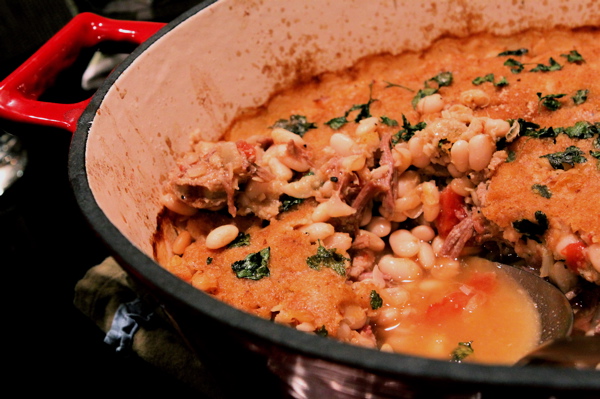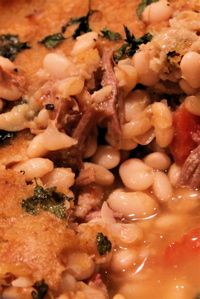
A quick glance at the recipe for Cassoulet de Canard from Michael Lewis via Epicurious – all three pages of it – and it’s clear that adventure is afoot. The ingredient list reads like a butcher’s inventory sheet, listing pork rind, confit duck legs, salted slab bacon, mutton bones, goose fat and garlic-pork sausage, among the many herbs and spices, beans and cooking liquids.
But once committed to cooking cassoulet, there is no going back.

Larousse Gastronomique describes cassoulet as a French haricot bean stew. Its name is derived from the earthen-ware dish in which it’s cooked. Typically, it has a bread crumb crust that is periodically broken and incorporated into the stew during the cooking process. Although the reliance upon white beans cannot be disputed, there is much debate surrounding the remaining ingredients that compose a cassoulet (although it is commonly accepted that 70 percent should be beans, stock and herbs and the remaining 30 percent should be the meats). Mastering the Art of French Cooking, Volume One states: “A cassoulet can be made anywhere out of beans and whatever the traditional meats are available. The important item is flavor, which comes largely from the liquid the beans and meat are cooked in.” The cassoulet recipe that follows is inspired by this more liberal approach to the dish.
Reader comments provided valuable perspective to the recipe. First, it was determined that the recipe’s claim to serve ten was grossly understated. Halving the amount of ingredients, in fact, provided ten servings.
Other comments faciliatated the cooking of this meal without breaking the bank or spirit. Omit the pork rind, use regular thick-sliced bacon, utilize the duck fat from the confit legs in place of the goose fat, substitute organic whole canned tomatoes for fresh (since they’re not in season) and soak the beans overnight to skip the second cooking. Hint: mark up a copy of the recipe with all alterations so the cooking process would go smoothly and without confusion.
Time to set the plan in motion.
Although many of the meats and fat had been substituted or omitted, there was still the issue of locating locally sourced confit duck legs, mutton or lamb bones and fresh garlic-pork sausage. This dilemma was solved with one phone call to Clancey’s Meat and Fish, a small friendly butcher shop in Linden Hills that carries only locally sourced products. The butcher had all the ingredients needed and further impressed by inquiring — after hearing the first few ingredients on the list: “Are you making a cassoulet?”
Cooking for a Sunday night meal began Saturday afternoon. First, the task of scraping off the fat from the confit legs and shredded the meat (a surprisingly enjoyable part of the process that’s described in the recipe as the “nasty work”). The lamb bones and onion were browned and then simmered with the tomatoes, duck and additional flavorings and liquids (bay leaves, beef stock, garlic, white wine and pepper). This simmered for an hour and half, cooled and then spent the night in the refrigerator. The beans were soaked in water overnight, which eliminated the need for a second simmer.

The next morning, the beans were simmered for an hour with the bacon, onion, bouquet garni (a make-shift one made with a coffee filter in lieu of cheesecloth) and salt. The tomato/meat mixture was retrieved from the refrigerator, bones and leaves discarded and the duck meat removed and reserved. The beans were finished by removing the fat from the bacon and cutting it into small pieces, discarding the bouquet garni, then draining and pouring them into the pot with the tomatoes. The sausages (house-made garlic-shallot sausages) were browned and then cut into rounds and reserved.
To assemble the cassoulet, beans were spread on the bottom of a 7-quart caste iron pot, followed by a layer of sausage and bacon, then a layer of beans, then duck, beans, sausage, etc. ending with a layer of beans. The remaining liquid was then poured into the cassoulet (running out of liquid, more beef stock was subbed in – not ideal, but it worked) until the beans were covered. Then the bread crumbs and parsley were sprinkled on top. This baked in the oven for an hour.
How did it turn out?

Coming out of the oven, the cassoulet held a presence in the room – a large steaming pot of beans and meat with a rich, hearty aroma. It was served with a simple green salad with a light vinaigrette and slices of hearty bread to mop up the juices. As we sat down, one guest commented that she loves cassoulet and that she had even eaten it out of can in France. My new competition: cassoulet-in-a-can.
Tasting at each step of the cooking process revealed an overpoweringly gamey flavor to the tomato/duck mixture and the taste of pure bacon permeating the beans. This raised a question: Who would win this battle of duck vs. pig in the oven show-down? But the final flavor was extremely rich and not at all overpowering; each component held its own, yet yielded to the others in complement. It seems likely that this gave that cassoulet-in-a-can a run for its money.
While this kind of kitchen challenge makes for a character-building (and arguably fun) experience, there are easier ways to taste cassoulet. Try one at one of the following restaurants: Meritage, Vincent or Grand Cafe.
In Julia Child’s The French Chef Cookbook, she writes about cassoulet: “you can prepare it in one day, but two or even three days of leisurely on-and-off cooking make it easier.” Easier? Leisurely? Good one, Julia! You kill me!

I love what Elizabeth David says about cassoulet in A Book of Mediterranean Food:
“When you consider that in the rich agricultural country of the Languedoc every farmer’s wife has the ingredients of the dish within arm’s length, festoons of sausages and hams hanging in her kitchen, jars of goose and pork preserved in their own fat on her larder shelves, you understand how the cassoulet came into being; it was evolved to make the best use of the local materials…”
I guess ideally I would also have festoons of sausages, ham, and duck and pork confit sitting around but since I don’t I usually try to make cassoulet-like dishes using ingredients that are more readily available locally, following the spirit if not the letter of the cassoulet.
If you want to taste a real cassoulet I would strongly advise you to avoid the insipid excuse for a cassoulet served at Vincent. Just being French does not mat Vincent a good cook.
When I lived in France, I was told that cassoulet was conceived as a meal to help gain strength before fighting off the English…